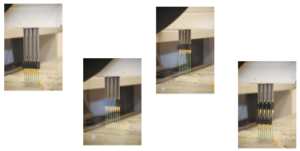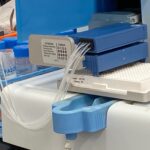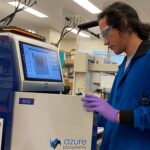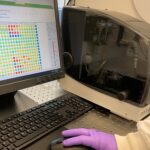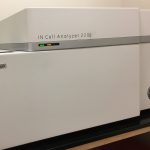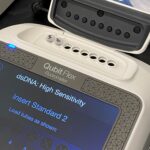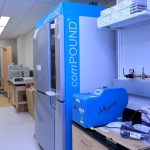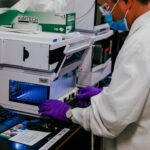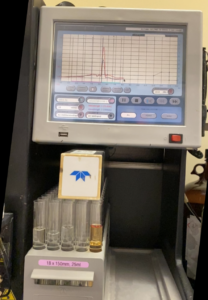Resources and Equipment
Resources and Equipment
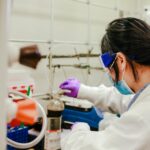 The Center for Integrative Chemical Biology and Drug Discovery (CICBDD) was created with the mission of bringing dedicated high throughput screening and medicinal chemistry expertise to bear on biological targets of therapeutic relevance under investigation by UNC faculty. Synthetic and computational chemists, and assay development/compound profiling scientists work in the Center and create dedicated, interdisciplinary project teams to progress targets through the probe and drug discovery process. The CICBDD therefore has the staff, equipment and expertise to progress biological targets through the assay development, hit generation and hit-to-lead/probe/lead optimization phases.
The Center for Integrative Chemical Biology and Drug Discovery (CICBDD) was created with the mission of bringing dedicated high throughput screening and medicinal chemistry expertise to bear on biological targets of therapeutic relevance under investigation by UNC faculty. Synthetic and computational chemists, and assay development/compound profiling scientists work in the Center and create dedicated, interdisciplinary project teams to progress targets through the probe and drug discovery process. The CICBDD therefore has the staff, equipment and expertise to progress biological targets through the assay development, hit generation and hit-to-lead/probe/lead optimization phases.
The home of the CICBDD is Marsico Hall, constructed in 2014 and located in the heart of UNC’s biomedical research  campus and physically connected to the Lineberger Comprehensive Cancer Center (LCCC). Laboratory accommodations for the Center consist of ~10,000 sq.ft. on the third and fourth floors of Marsico Hall. There are 25 X 6 ft fume hoods and 10 x 8 ft fume hoods, as well as 5 labs for cell culture and a dedicated lab for fluorescence microscopy in this space. The Center also has a dedicated fine chemical storeroom with a bar-coded inventory system and a walk-in -20°C freezer for storage of compound plates. The CICBDD is well equipped for state-of-the-art organic and medicinal chemistry, along with protein expression, biochemical assay development and focused or diversity-based screening.
campus and physically connected to the Lineberger Comprehensive Cancer Center (LCCC). Laboratory accommodations for the Center consist of ~10,000 sq.ft. on the third and fourth floors of Marsico Hall. There are 25 X 6 ft fume hoods and 10 x 8 ft fume hoods, as well as 5 labs for cell culture and a dedicated lab for fluorescence microscopy in this space. The Center also has a dedicated fine chemical storeroom with a bar-coded inventory system and a walk-in -20°C freezer for storage of compound plates. The CICBDD is well equipped for state-of-the-art organic and medicinal chemistry, along with protein expression, biochemical assay development and focused or diversity-based screening.
Lead Discovery & Characterization, Ken Pearce, Director
Medicinal Chemistry, Xiaodong Wang, Director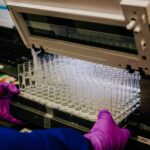
The Lead Discovery and Characterization Group handles all compound management and is 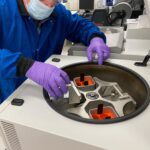 equipped to develop https://cicbdd.web.unc.edu/chemical-biology/screening assays using industry standard best practices and technologies. The
equipped to develop https://cicbdd.web.unc.edu/chemical-biology/screening assays using industry standard best practices and technologies. The 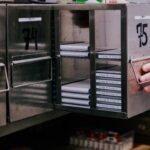 equipment within LD&C is organized around an “islands of automation” concept where each device is capable of walk away operation sufficient to process 30-50 plates. This strategy has been proven to be maximally effective in environments where flexibility is required, and as
equipment within LD&C is organized around an “islands of automation” concept where each device is capable of walk away operation sufficient to process 30-50 plates. This strategy has been proven to be maximally effective in environments where flexibility is required, and as say formats may vary significantly over time. All equipment is maintained at or above the manufacturers recommended maintenance intervals for testing and calibration. Our medicinal chemistry efforts are project based with a faculty generated lead compound. The medicinal chemistry team can support 3-5 hit to probe/lead projects concurrently.
say formats may vary significantly over time. All equipment is maintained at or above the manufacturers recommended maintenance intervals for testing and calibration. Our medicinal chemistry efforts are project based with a faculty generated lead compound. The medicinal chemistry team can support 3-5 hit to probe/lead projects concurrently.
Computational Biophysics, Konstantin Popov, Director
 Research staff in Computational Biophysics are equipped with personal laptops with network access to all UNC IT resources (e-library, etc.) and have Intel Xeon workstations with Nvidia Quadro graphics cards with network access to all UNC IT resources. Computational Biophysics relies on vast resources for computational modeling available at UNC. Research Computing, a division of the Office for Information Technology Services, currently offers access to two state-of-the-art high-performance computing cluster (Longleaf) and a number of software packages to support research computing including Matlab, GROMACS, NAMD, AMBER, MBOSS, DOCK, Schrodinger, GCG, Pipeline Pilot, Discovery Studio and Gaussian.
Research staff in Computational Biophysics are equipped with personal laptops with network access to all UNC IT resources (e-library, etc.) and have Intel Xeon workstations with Nvidia Quadro graphics cards with network access to all UNC IT resources. Computational Biophysics relies on vast resources for computational modeling available at UNC. Research Computing, a division of the Office for Information Technology Services, currently offers access to two state-of-the-art high-performance computing cluster (Longleaf) and a number of software packages to support research computing including Matlab, GROMACS, NAMD, AMBER, MBOSS, DOCK, Schrodinger, GCG, Pipeline Pilot, Discovery Studio and Gaussian.
Current Equipment Available at the CICBDD
Liquid Handling Instruments
Plate Reading Instruments/Spectrophotometers
Protein Purification
| Device | Manufacturer | Capabilities |
|---|---|---|
| Akta FPLC/HPLC (3) | GE Lifesciences | Protein purification using high pressure column chromatography |
Compound Storage; Other
Chemistry
Computing
All faculty, research staff, students and postdoctoral fellows in the CICBDD have either personal laptops or access to a desk- based computer with network access to all UNC IT resources (e-library, etc.). The CICBDD relies on the vast resources for computational modeling available at UNC. Academic Technology & Networks (ATN), a division of the Office for Information Technology Services, currently offers a number of software packages to support research computing including EMBOSS, DOCK, Clustal, CNSsolve, GCG, Sybyl, InsightII, Genomax, Cerius2 and most InsightII modules for homology-related docking for structural searches and molecular visualization packages such as Spock and Denzo at an annual cost of over $100,000. Recent ATN hardware commitments in support of computational biology and genomic computing include over $600,000 of the $1.3 million spent upgrading our SGI system to an Origin 3800 with 64 processors and 64 GB of memory, and $60,000 toward the installation of a 184-processor Beowulf Cluster with 184 GB of memory and a Myrinet interconnect, and the acquisition of a 44 processor SUN ES-15000 worth $2.4 million.
UNC shared facilities
UNC Research Computing provides a world-class computing infrastructure as well as other technology tools and capabilities to support the research needs of UNC researchers. The Research Computing group currently offers a number of computing services for researchers at UNC-Chapel Hill:
- The Longleaf cluster is a Linux-based computing system available to researchers across the campus free of charge. With nearly 6500 conventional compute cores delivering 13,000 threads (hyperthreading is enabled) and a large, fast scratch disk space, it provides an environment that is optimized for memory and I/O intensive, loosely coupled workloads with an emphasis on aggregate job throughput over individual job performance.
- The Dogwood cluster is a Linux-based computing system available to researchers across the campus free of charge. With over 11,000 computing cores, a low latency, high bandwidth Infiniband EDR switching fabric and a large scratch disk space, it provides an environment that is optimized for large, multi-node, tightly coupled computational models typically using a message passing (e.g. MPI) or hybrid (OpenMP + MPI) programming model. Most of the cluster is comprised of nodes with Intel Xeon processors with the Broadwell-EP micro-architecture and 44 cores per node. There is a partition with newer Intel Skylake nodes as well as a KNL partition, with Intel Xeon Phi processors (Knight’s Landing) and GPUs (Nvidia Tesla P100 and V100) nodes for development purposes.
Both clusters have access to a variety of statistical software packages (such as SAS and Stata), mathematical software packages (such as Matlab and Mathematica) and scientific software packages (such as Gaussian, Amber, GROMACS, Schrodinger) and deep learning frameworks (TensorFlow, PyTorch, Keras, etc).
Cloud Computing
Carolina CloudApps is a UNC managed platform for developing and deploying web applications. The managed software encompasses the underlying operating system and core software, such as web servers and development languages.

